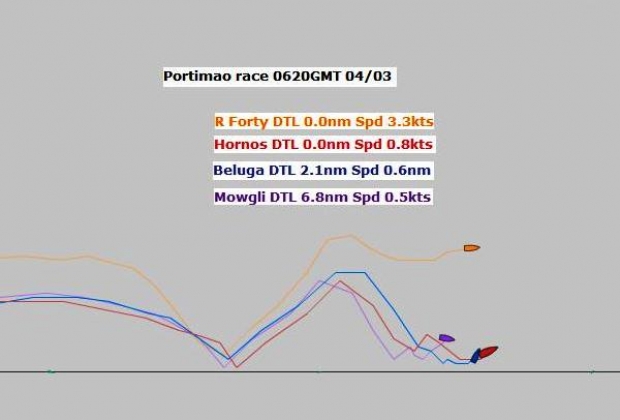2.8 miles of separation
Wednesday March 4th 2009, Author: Ollie Dewar, Location: United Kingdom
This morning, the Portimão Global Ocean Race leadership battle is intensifying. After four days at the front the tightly packed double-handed fleet, Felipe Cubillos and José Muñoz on
Desafio Cabo de Hornos temporarily handed pole position to the German duo of Boris Herrmann and Felix Oehme on
Beluga Racer. In the latest 0620 GMT (04/03) position poll, the Chileans have regained the lead with
Beluga Racer in second place 2.8 miles astern of
Desafio Cabo de Hornos and the British Class 40,
Team Mowgli, just four miles behind the German duo. Meanwhile, the fleet’s only solo sailor, Michel Kleinjans, has chosen to keep slightly north of the pack, putting a 20 mile wide safety buffer between the latitude 45°S southern limit and his Open 40,
Roaring Forty, while continuing to harass the double-handed fleet, just seven miles behind the Class 40 leader.
On Monday, Beluga Racer was trailing the fleet with a 43 mile deficit on the leaders, but the recent option of keeping south, close to the 45°S Leg 3 southern limit, while Desafio Cabo de Hornos and Team Mowgli gambled to the north, near the centre of a high pressure system, has proved successful. In the early evening yesterday, The German team moved up to second place, overhauling Jeremy Salvesen and David Thomson on Team Mowgli and at 0020 GMT today, Herrmann and Oehme moved into first place with a 1.2 mile lead over Cubillos and Muñoz on Desafio Cabo de Hornos before the Chileans snatched pole position three hours later. “I confess that this is completely and totally fascinating,” admits Cubillos this morning. “We have the English and the Germans under seven miles behind us and all three of us have turned to the north-east to get a little clearance from latitude 45,” he continues as Desafio Cabo de Hornos skates across the top of the southern limit with a three mile margin.
In the vast expanse of the Pacific Ocean after 11 days of racing in Leg 3, Distance To Leader data is still in single figures with the four boats spread over seven miles east-west in a narrow corridor only 17 miles wide. “I liked Sunday, when the competition was 50 and 17 miles behind us respectively,” says Cubillos. “But this also I like. It’s fascinating: the pure, total, clean competition with all the boats in identical wind conditions.” Holding a narrow lead, the skipper of Desafio Cabo de Hornos is certain he has a psychological advantage: “But there is a difference,” he explains. “They are British and German and we’re Chilean. And, of course, we’re heading towards Chile. We fight for every metre and last night José and I took turns trimming, swapping over frequently. It’s as if the race finishes in one hour whereas, in reality, we have a little less than a month to the finish line.”
Yesterday, Jeremy Salvesen on Team Mowgli was coming to terms with the unbelievably close, mid-ocean racing. “All the combined wit, wisdom and experience of the crews and their shore teams and weather routers in this race and all the tactical manoeuvrings have come to nought,” he believes. “Not since the fleet originally split and went their own ways about an hour into the Cook Strait on leaving Wellington Harbour have all the boats been so close together.” With the boat-to-boat images sent in from the fleet illustrating the type of compression normally found shortly before the five minute gun in an inshore, round the buoys race, the proximity is truly astonishing.
“Shortly after noon today (03/03), the fleet converged and for the first time in ten days - and really since leaving Portugal way back in October last year - the whole fleet have been within sight of each other. Perhaps this is all taking the family atmosphere of the race a little too far!” Grouped so tightly together with the closest land 1,000 miles to the north, the crews have been in contact: “Most of us managed to talk at some point over the VHF radio,” confirms Salvesen. “It was good to hear that everyone is getting on so well with so few problems aboard - the worst of which appears to be the demise of Michel's iPod charger! An important bit of kit for a single-hander....”
Since midnight, fleet speed averages have declined with the double-handed fleet slamming straight into a windless zone and averaging below one knot over the past three hours with weather models showing just five knots of southerly breeze. Only 17 miles north of the three double-handed boats, Michel Kleinjans and Roaring Forty are polling the best speed average at a little over three knots, giving an indication of just how localised and fluky the current conditions are in the middle of the Pacific.









Latest Comments
Add a comment - Members log in